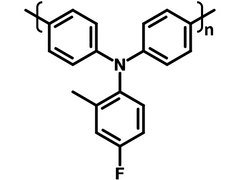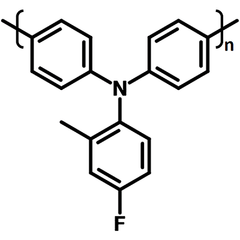Fluoro-PTAA (1F-PTAA)
Materials, Semiconducting PolymersFluoro-PTAA, HTL material for perovskite and polymer solar cells
Used to improve device efficiency and device operating lifetime
Fluoro-PTAA (specifically known as 1F-PTAA), or poly(bis(4-phenyl)(4-fluoro-2-methylphenyl)amine, is a mono-fluorinated poly(triaryl)amine which is used as a hole transporting layer (HTL) for perovskite and polymer solar cells.
With the substitution of the methyl to fluorine on the 4-postion, the HOMO energy level is significantly lowered from 5.14 eV to 5.52 eV, which is essential to increase the open voltage (VOC) thus to improve the device efficiency. Fluorination of PTAA also drastically improves device operating lifetime, moisture and thermal stress stability. Fluoro-PTAA is therefore considered a great alternative as a hole transporting layer material for PTAA and Spiro-OMeTAD.
PTAA from Ossila was used in the high-impact paper (IF 30.85), Multiply Charged Conjugated Polyelectrolytes as a Multifunctional Interlayer for Efficient and Scalable Perovskite Solar Cells, E. Jung et al., Adv. Mater., 2002333 (2020); DOI: 10.1002/adma.202002333.
Improve stability
improve device efficiency and Stability
Lowered HOMO energy level
5.14 eV to 5.52 eV
Improve lifetime
Improve device operating lifetime
Hole-transport layer
improved device performance
Perovskite solar cells (PSCs) with hexyltrimethylammounium bromide (HTAB) cast perovskite quantum wells (PQWs) and 1F-PTAA as HTL demonstrated efficiencies exceeding 22% along with significantly improved device stability [2]
Device Structure(s)
| Device structure |
FTO/SnO2/Cs0.05FA0.81MA0.14PbI2.55Br0.45/1F-PTAA/Au [2] |
| JSC (mA cm-2) | 23.11 |
| VOC (V) | 1.15 |
| FF (%) | 75.61 |
| PCE | 20.09 |
| Device structure |
FTO/SnO2/Cs0.05FA0.81MA0.14PbI2.55Br0.451F-PTAA/Au [2] |
| JSC (mA cm-2) | 23.72 |
| VOC (V) | 1.21 |
| FF (%) | 77.21 |
| PCE | 22.16 |
General Information
| CAS number | N.A. |
| Chemical formula | (C19H14NF)n |
| Full name | Poly(bis(4-phenyl)(4-fluoro-2-methylphenyl)amine |
| Molecular weight | Please see batch details |
| HOMO / LUMO | HOMO 5.52 eV, LUMO 2.55 eV [1] |
| Recommended solvents | Chlorobenzene, chloroform, THF and toluene |
| Synonyms | F-PTAA, FMe-PTAA, 1F-PTAA |
| Classification / Family |
Polyamines, Hole-transport layer materials, Electron-blocking layer materials, Organic semiconducting materials, Organic photovoltaics, Polymer solar cells, Perovskite solar cells, OLED materials |
Chemical Structure

MSDS Documentation
Fluoro-PTAA (1F-PTAA) MSDS sheet
Pricing
| Batch | Quantity | Price |
| M2346A | 100 mg | £400 |
| M2346A | 250 mg | £800 |
| M2346A | 500 mg | £1400 |
Batch details
| Batch | Mw | PDI | Stock info |
| M2346A1 | 30,000 | 1.4 | In Stock |
| M2346A2 | 90,000 | 1.9 | In Stock |
| M2346A3 | 160,000 | 2.7 | In Stock |
Literature and Reviews
- Sequentially Fluorinated PTAA Polymers for Enhancing VOC of High-Performance Perovskite Solar Cells, Y. Kim et al., Adv. Energy Mater., 8 (29), 1801668 (2018); DOI: 10.1002/aenm.201801668.
- Perovskite Quantum Wells Formation Mechanism for Stable Efficient Perovskite Photovoltaics—A Real-Time Phase-Transition Study, H. Hu et al., Adv. Mater., 33 (17), 2006238 (2020); DOI: 10.1002/adma.202006238.
- New Strategies for Defect Passivation in High-Efficiency Perovskite Solar Cells, S. Akin et al., Adv. Energy Mater., 10 (13), 1903090 (2020); DOI: 10.1002/aenm.201903090..
